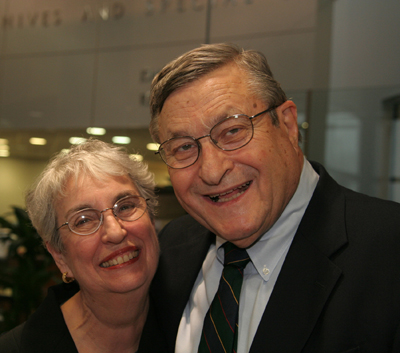
Emanuel (Manny) Parzen and his wife, Carol, photographed at his 75th birthday tribute celebrations.
Photo courtesy of Texas A&M University.
Professor Emanuel Parzen, a long time faculty member in the Statistics Department at Texas A&M University, and expert in signal detection theory and time series analysis, died on Saturday, February 6, 2016, in Boca Raton, Fla. He was 86.
Parzen, who was born on April 21, 1929, in New York City, received his master’s degree in mathematics in 1951 and a PhD in mathematics and statistics in 1953 from the University of California, Berkeley after earning an undergraduate degree in mathematics from Harvard University in 1949. He had held faculty appointments at Columbia University (1953–56), Stanford University (1956–70) and State University of New York (SUNY) in Buffalo (1970–78), prior to coming to Texas A&M as a University Distinguished Professor. At Texas A&M he worked with the inaugural head of Statistics, H.O. Hartley, and subsequent administrators throughout his three-decade Texas A&M career to establish the department as one of the nation’s leading programs in both graduate education and scholarly research. He had been a fellow at Imperial College London, IBM Systems Research Institute and the Center for Advanced Study in the Behavioral Sciences at Stanford, as well as a visiting professor at the Sloan School of MIT, the Department of Statistics at Harvard and the Department of Biostatistics at Harvard.
Among other career achievements, Parzen pioneered the use of kernel density estimation—named the Parzen window in his honor—and authored six books, including Modern Probability Theory and Its Applications, which is considered one of the classic defining texts in probability theory. Thanks to him, Texas A&M is home to the Emanuel Parzen Prize Lecture Series, established in the Department of Statistics in his honor in 1994 and presented in even-numbered years to North American statisticians in recognition of outstanding careers in the discipline and profession of statistics.
“Manny Parzen was a pioneer in statistics during its nascent stages of development in the 1960s,” said Dr. Valen E. Johnson, professor and head of Texas A&M Statistics. “He played a central role in the development of the theory of stochastic processes and was a pioneer in the fields of time series and spectral analyses in addition to making important contributions in the area of nonparametric statistics. His textbook Modern Probability Theory and its Applications is a classic text that continues to be widely used as reference in the field today.”
“I will miss Manny so much,” said Dr. H. Joseph Newton, who came to Texas A&M along with Parzen in 1978 with his encouragement and knew Parzen for 45 years—first as his PhD student at SUNY Buffalo and later as Parzen’s department head (1990–97) and dean (2002–15). He also interviewed Parzen for Project Euclid in 2002.
Parzen was an elected fellow of the American Statistical Association, the IMS and the American Association for the Advancement of Science.
In 1994, he was honored with the ASA’s prestigious Samuel S. Wilks Memorial Medal, “for outstanding research in time-series analysis, especially for his innovative introduction of reproducing kernel spaces, spectral analysis and spectrum smoothing; for pioneering contributions in quantile and density quantile functions and estimation; for unusually successful and influential textbooks in probability and stochastic processes; for excellent and enthusiastic teaching and dissemination of statistical knowledge; and for a commitment to service on society councils, government advisory committees and editorial boards.”
Most recently, Parzen received the 2005 Gottfried E. Noether Award, “for a lifetime of outstanding achievements and contributions in the field of nonparametric statistics, both in research and teaching.”
Parzen is survived by his wife of 57 years, Carol; his daughter Sarah and son-in-law Martin; his son Michael and daughter-in-law Andrea; and six grandchildren.
—
Written by H. Joseph Newton, Texas A&M University
1 comment on “Obituary: Emanuel Parzen 1929–2016”